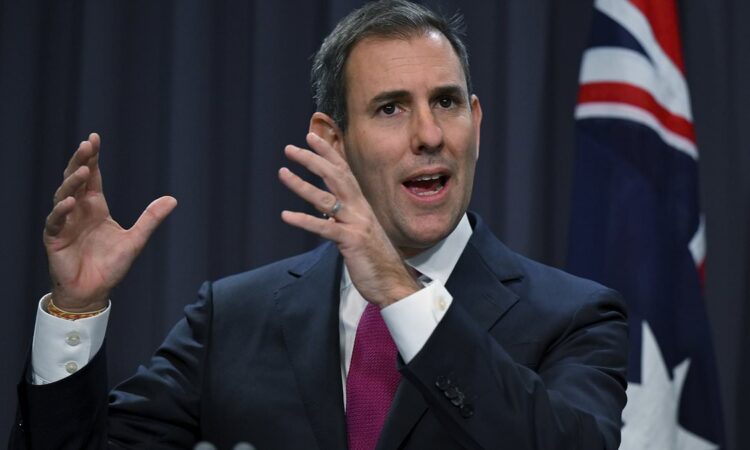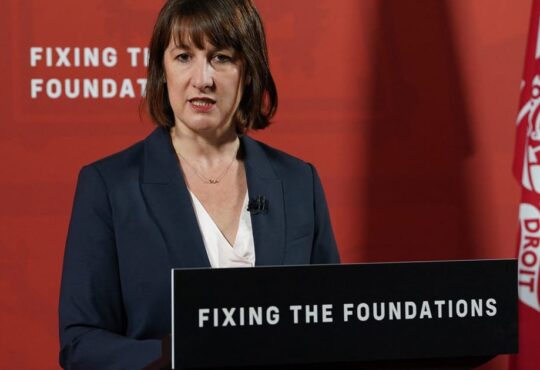
By Stephen Johnson, Economics Reporter For Daily Mail Australia
04:00 08 Nov 2023, updated 03:10 09 Nov 2023
Jim Chalmers could stand up to the public service bureaucrats and demand a cut to immigration during a cost of living crisis like previous Labor governments.
The Treasurer could also cut fuel excise, like his Liberal predecessor did, so Australians battling surging rents and mortgage repayments have more money in their pocket.
That $20 saving at the petrol pump would more likely be spent on bills.
Record immigration levels have caused capital city rents to surge by 16 per cent during the past year.
The rapid population growth has also caused house prices in Sydney, Brisbane and Perth to surge by digit-double figures since the start of January, particularly benefiting baby boomers who are much more likely to own property outright.
They were the ones who benefited when previous Labor governments in the 1970s, 1980s and 1990s slashed immigration during a cost of living crisis, and put a lid on house price rises and rents.
The Reserve Bank of Australia on Tuesday raised interest rates for the 13th time in 18 months, taking the cash rate to a 12-year high of 4.35 per cent, after inflation in the year to September grew by 5.4 per cent.
New Governor Michele Bullock is now expecting inflation to take longer to moderate, forecasting a return to the two to three per cent target in late 2025, instead of mid-2025 as forecast as recently as August.
Monthly mortgage repayments in November will be 68 per cent higher than they were in May 2022, when the RBA cash rate was still at a record low of 0.1 per cent.
Yet house prices have this year been surging, locking young people out of real estate, as new migrants with money compete to either buy or rent a home.
Dr Chalmers has this year repeatedly suggested the government doesn’t control or set a target on long-term and permanent arrivals, which includes skilled migrants and international students.
‘That isn’t a government policy or a government target,’ he told the ABC’s Q+A program in May.
‘It’s not a floor or ceiling, it’s not something the government determines.’
This is despite a record 400,000 migrants flooding into Australia in just a year, putting it well above Treasury’s forecast of 315,000 arrivals in 2023-24.
Dr Chalmers and his department are expecting 1.5million migrants to move to Australia in the five years to June 2027.
The Treasurer in 2004 wrote a PhD thesis on former Labor prime minister Paul Keating – titled Brawler Statesman – and regards him as a hero.
The last time immigration was slashed outside a pandemic
Ironically, the Keating government was the last administration outside of a world war, depression or a pandemic to halve immigration numbers, which saw net overseas arrivals fall from 81,669 in 1991 to 51,358 in 1992 and 34,822 in 1993.
A Labor government, led by a vocal advocate of multiculturalism and family reunions, three decades ago halved immigration levels in just two years during an era of double-digit unemployment.
This coincided with inflation falling from 6.9 per cent in December 1990 to just 0.3 per cent in December 1992.
Inflation would stay below three per cent until the end of 1994, even as Reserve Bank interest rates fell from 8.5 per cent in January 1992 to 4.75 per cent by July 1993.
Sydney’s median house price in 1992, in the aftermath of a recession, rose by just 0.7 per cent to $183,300, followed by a 2.6 per cent increase in 1993 taking it to $188,000.
The 378-page thesis Dr Chalmers wrote, when he was a doctoral student at Australian National University in Canberra, made six references to immigration but no mention was made about the Keating government’s overall intake – just who gave policy advice and how many questions the Opposition asked about the issue in Parliament.
Previous Labor governments have slashed immigration during a cost of living crisis – and Australia’s oldest baby boomers were adults when this happened.
Former prime minister Gough Whitlam and his last treasurer Bill Hayden cut immigration from 87,248 in 1974 to just 13,515 in 1975 as the OPEC oil crisis saw inflation climb to 17.7 per cent.
House price growth slowed from 16 per cent to 7.8 per cent, back when Sydney’s median house price was at $34,300, Macquarie University data showed.
Bob Hawke’s government, with Keating as treasurer, cut immigration to 54,995 in 1983, down from 102,709 in 1982 under Liberal PM Malcolm Fraser, during a stagflation recession that simultaneously saddled Australia with 10 per cent unemployment and 11.4 per cent inflation.
In 2023, unemployment is at 3.6 per cent, rivalling levels seen in 1974, and the likes of the Business Council of Australia are lobbying for high immigration to fill skill shortages and make up for Australia’s border closure in 2020 and 2021.
Solve unaffordable housing
Sydney, the city receiving the largest share of new overseas migrants, has seen its median house prices soar by 12.1 per cent since January to $1.397million, CoreLogic data for October showed.
A typical Sydney house is well beyond the reach of an average, income earner on a $95,581 salary and a couple would now have to earn $186,252 between them just to afford a mortgage.
Brisbane, a recipient of interstate migration, saw its mid-point house price this year climb by 10.3 per cent to $860,465, as Perth prices rose by 11.1 per cent to $660,069.
CoreLogic’s head of research in Australia Eliza Owen said record-high immigration levels were pushing up house prices, despite higher interest rates.
‘Overseas migration is frequently being called out as one of the primary factors influencing the housing market,’ she said.
‘In the face of high interest rates, low consumer sentiment and stretched housing affordability, values and rents continue to rise and vacancy rates plummet as net overseas migration has hit record highs.’
Capital city rents soared by 16 per cent in the year to October, SQM Research data showed.
But in Melbourne, house rents have climbed by 20.7 per cent to $702 a week.
The national rental vacancy rate was just 1.1 per cent last month.
Cut fuel excise
Cutting fuel excise temporarily, as the previous Coalition did, would reduce petrol bills and particularly help those battling rising mortgage costs or rents.
The monthly inflation data from the Australian Bureau of Statistics data showed petrol prices surging by 19.7 per cent in the year to September.
Dr Chalmers on Tuesday singled out high petrol prices, following the Reserve Bank’s first rate rise since June, as it proceeds with the most severe pace of monetary policy tightening since 1989.
‘The primary driver of inflation in the most recent data was petrol but there are other inflationary pressures in our economy as well and the Reserve Bank is responding to that,’ he said.
But he has ruled out reviving an excise halving, despite boasting about a $22billion surplus for 2022-23, the first in 15 years and the first for Labor federally since 1989.
Former Liberal treasurer Josh Frydenberg in his March 2022 Budget halved excise for six months to 22.1 cents a litre, based on the old rate of 44.2 cents, after Russia’s Ukraine invasion pushed petrol prices above $2 a litre.
This cost the Budget $3billion and helped save $17.68 for a motorist filling up a Toyota HiLux ute.
Motorists are now paying 48.8 cents a litre in fuel excise, with the tax indexed for inflation.
Halving this excise would save a ute driver $19.50 at the petrol pump.
A weaker Australian dollar, now worth 64 US cents, is also making imports more expensive.
The Israel-Hamas conflict could also encourage oil producing nations to reduce supply and put up prices.
But Dr Chalmers has, for now, downplayed the prospect of halving the fuel tax like the previous Coalition government did in March 2022 shortly before losing the last election.
‘The relief there in the last budget of the former government was not ended by us, it was timed to end after a certain period and it ended and we didn’t restart it,’ he told Sky News business editor Ross Greenwood on Sunday.
Energy policy problems
Electricity prices surged by 18 per cent annually in September, even though Prime Minister Anthony Albanese went to the last election promising to reduce average power bills by $275 by 2025.
But Dr Chalmers argued that without rebates of up to $500, in the May Budget, electricity bills would have been even worse, citing the Australian Bureau of Statistics giving credit to the Energy Bill Relief Fund rebates.
Gas prices went up by 12.7 per cent, even though the federal government in December 2022 intervened in the gas market and capped wholesale prices at $12 a gigajoule for a year.
Ms Bullock has signalled more rate rises were possible.
Acting shadow treasurer Jane Hume said the prospect of a rate cut was now looking remote.
‘The Albanese Labor Government’s lack of a plan to tackle inflation is gambling with Australians money and with our economy,’ she said.
‘As a result, interest rates are going to be higher for longer and its hardworking Australians who are paying the price.’






